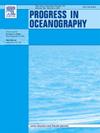Impact of multiple drivers on the trophic position, functional diversity, and ecological memory of benthic macrofauna – analysis of 40 years of data using a complex model hierarchy
IF 3.6
3区 地球科学
Q1 OCEANOGRAPHY
引用次数: 0
Abstract
This study analyzed the potential influence of multiple drivers, such as climate variability and regime shifts, on benthic life using long-term data sets describing the abundance, biomass, and stable isotopes (1978–2017) of two benthic species in the southern North Sea, generated from preserved samples. Specifically, changes in nitrogen supply and trophic position were identified by bulk and amino-acid-specific isotope analyses of the native warm–temperate bivalve Fabulina fabula and the native cold–temperate polychaete Magelona spp., which together made up > 60 % of the biomass and abundance of all benthic animals in the original samples. Bulk stable isotopes ratios of total carbon and nitrogen as well as amino-acid specific-isotope ratios were corrected with respect to the preservation method. Statistical downscaling and a scanning t-test were applied to various time series of climate, Rhine and Maas riverine runoff, and local monitoring at the island of Norderney. The scanning t-test identified three regime shifts in the drivers and macrofaunal responses, which allowed four regimes, occurring during the periods 1978–1988, 1989–2000, 2001–2009, and 2010–2017, to be distinguished.
Quantitative metrics using a phenotype-based approach were computed for all data and for the four identified regimes, to characterize aspects of the trophic position and functional diversity of the two macrofaunal species. Functional diversity in a single species decreased over time, indicating a normalization of feeding habits and increased productivity under decreasing nutrient loads, a shift in biomass from specialist to generalist, and an increase in stability and resilience after 2000. Based on the de-correlation time, an ecological memory of the system of ∼ 3 years was identified for F. fabula and Magelona spp., attributable to an internal basin mode in climate variability driven by atmosphere–ocean interactions in the North Atlantic.
多种驱动因素对底栖大型动物营养地位、功能多样性和生态记忆的影响——基于复杂层次模型的40年数据分析
本研究使用描述北海南部两种底栖生物丰度、生物量和稳定同位素(1978-2017)的长期数据集,分析了气候变化和制度变化等多种驱动因素对底栖生物的潜在影响,这些数据集是由保存的样本生成的。具体而言,通过对原生暖温带双壳类Fabulina fabula和原生寒温带多毛类Magelona spp.的体积和氨基酸特异性同位素分析,确定了氮供应和营养地位的变化,这两种动物共同占原始样品中所有底栖动物生物量和丰度的60%。根据保存方法,校正了总碳、总氮的体积稳定同位素比值以及氨基酸比同位素比值。统计降尺度和扫描t检验应用于气候、莱茵河和马斯河径流的各种时间序列,以及诺德尼岛的当地监测。扫描t检验确定了驱动因素和大型动物响应的三种模式转变,从而区分了1978-1988年、1989-2000年、2001-2009年和2010-2017年期间的四种模式。采用基于表型的方法对所有数据和四种已确定的制度计算定量指标,以表征两种大型动物物种的营养地位和功能多样性。单一物种的功能多样性随着时间的推移而减少,表明在营养负荷减少的情况下,摄食习惯正常化和生产力提高,生物量从专一型向多面手型转变,以及2000年后稳定性和恢复力的增加。基于去相关时间,确定了F. fabula和Magelona spp.系统的生态记忆为~ 3年,归因于北大西洋大气-海洋相互作用驱动的气候变率的内部盆地模式。
本文章由计算机程序翻译,如有差异,请以英文原文为准。
求助全文
约1分钟内获得全文
求助全文
来源期刊

Progress in Oceanography
地学-海洋学
CiteScore
7.20
自引率
4.90%
发文量
138
审稿时长
3 months
期刊介绍:
Progress in Oceanography publishes the longer, more comprehensive papers that most oceanographers feel are necessary, on occasion, to do justice to their work. Contributions are generally either a review of an aspect of oceanography or a treatise on an expanding oceanographic subject. The articles cover the entire spectrum of disciplines within the science of oceanography. Occasionally volumes are devoted to collections of papers and conference proceedings of exceptional interest. Essential reading for all oceanographers.
 求助内容:
求助内容: 应助结果提醒方式:
应助结果提醒方式:


